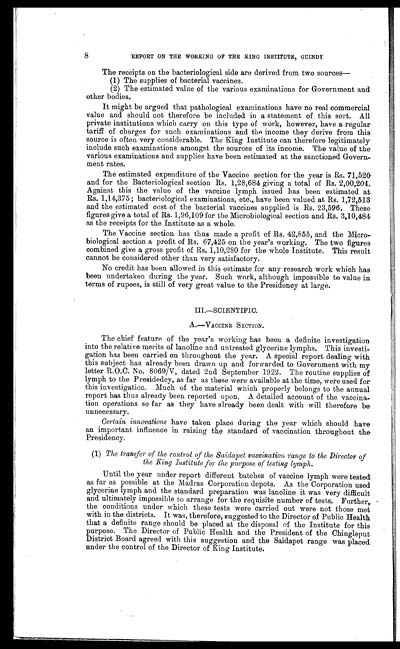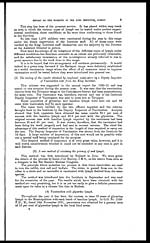Medicine - Institutions > Reports from medical colleges, schools and research institutions > Report of the King Institute of Preventive Medicine, Guindy > Reports on the working of the King Institute of Preventive Medicine, Guindy for the official year 1921-22 and the Micro-biological Section for the period from 1st January to 31st March 1921
(14) Page 8
Download files
Individual page:
Thumbnail gallery: Grid view | List view

8
REPORT ON THE WORKING OF THE KING INSTITUTE, GUINDY
The receipts on the bacteriological side are derived from two sources
(1) The supplies of bacterial vaccines.
(2) The estimated value of the various examinations for Government and
other bodies.
It might be argued that pathological examinations have no real commercial
value and should not therefore be included in a statement of this sort. All
private institutions which carry on this type of work, however, have a regular
tariff of charges for such examinations and the income they derive from this
source is often very considerable. The King Institute can therefore legitimately
include such examinations amongst the sources of its income. The value of the
various examinations and supplies have been estimated at the sanctioned Government
rates.
The estimated expenditure of the Vaccine section for the year is Rs. 71,520
and for the Bacteriological section Rs. 1,28,684 giving a total of Rs. 2,00,204.
Against this the value of the vaccine lymph issued has been estimated at.
Rs. 1,14,375; bacteriological examinations, etc., have been valued at Rs. 1,72,513
and the estimated cost of the bacterial vaccines supplied is Rs. 23,596. These
figures give a total of Rs. 1,96,109 for the Microbiological section and Rs. 3,10,484
as the receipts for the Institute as a whole.
The Vaccine section has thus made a profit of Rs. 42,855, and the Microbiological
section a profit of Rs. 67,425 on the year's working. The two figures
combined give a gross profit of Rs. 1,10,280 for the whole Institute. This result
cannot be considered other than very satisfactory.
No credit has been allowed in this estimate for any research work which has
been undertaken during the year. Such work, although impossible to value in
terms of rupees, is still of very great value to the Presidency at large.
III.—SCIENTIFIC.
A.—VACCINE SECTION.
The chief feature of the year's working has been a definite investigation
into the relative merits of lanoline and untreated glycerine lymphs. This investigation
has been carried on throughout the year. A special report dealing with
this subject has already been drawn up and forwarded to Government with my
letter R.O.C. N o. 8069/V, dated 2nd September 1922. The routine supplies of
lymph to the Presidedcy, as far as these were available at the time, were used for
this investigation. Much of the material which properly belongs to the annual
report has thus already been reported upon. A detailed account of the vaccination
operations so far as they have already been dealt with will therefore be
unnecessary.
Certain innovations have taken place during the year which should have
an important influence in raising the standard of vaccination throughout the
Presidency.
(1) The transfer of the control of the Saidapet vaccination range to the Director of
the King Institute for the purpose of testing lymph.
Until the year under report different batches of vaccine lymph were tested
as far as possible at the Madras Corporation depots. As the Corporation used
glycerine lymph and the standard preparation was lanoline it was very difficult
and ultimately impossible to arrange for the requisite number of tests. Further,
the conditions under which these tests were carried out were not those met
with in the districts. It was, therefore, suggested to the Director of Public Health
that a definite range should be placed at the disposal of the Institute for this
purpose. The Director of Public Health and the President of the Chingleput
District Board agreed with this suggestion and the Saidapet range was placed.
under the control of the Director of King Institute.
Set display mode to: Large image | Zoom image | Transcription
Images and transcriptions on this page, including medium image downloads, may be used under the Creative Commons Attribution 4.0 International Licence unless otherwise stated. ![]()
| Permanent URL | https://digital.nls.uk/74936369 |
|---|
| Description | 13 titles. Describes research work and conditions, treatments, vaccine production, medical education, public health and disease outbreaks. Extensive tables show mortality rates and patient admissions. These - some from asylums, jails, dispensaries, civil and police hospitals – will be useful to epidemiologists. |
|---|




